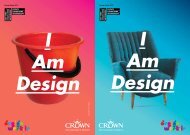IDI Creative Axis - Institute of Designers in Ireland
IDI Creative Axis - Institute of Designers in Ireland
IDI Creative Axis - Institute of Designers in Ireland
- No tags were found...
You also want an ePaper? Increase the reach of your titles
YUMPU automatically turns print PDFs into web optimized ePapers that Google loves.
RICHARDSEYMOUR17do’. To demonstrate he shows a clip <strong>of</strong> an olderman hopelessly fumbl<strong>in</strong>g with the stairlift he’dclaimed a moment ago was ‘brilliant’. Theanimal <strong>in</strong> us does one th<strong>in</strong>g, the m<strong>in</strong>d another.This attentive scrut<strong>in</strong>y has paid <strong>of</strong>f <strong>in</strong> many<strong>of</strong> Seymour Powell’s most successful projects.Take the Baby G watch. Ten years ago a group<strong>of</strong> Japanese executives from Casio came to seethe consultants, say<strong>in</strong>g they couldn’t sell theirwatches to women, and didn’t know why.Seymour Powell set forth with a camera tophotograph young women out and about <strong>in</strong>clubs and bars. What they found was youngwomen wear<strong>in</strong>g big, fat, male watches. Theysuggested Casio make big fat watches <strong>in</strong> nicecolours, but take the technology out <strong>of</strong> them -too geeky - and remove the Casio brand<strong>in</strong>g,s<strong>in</strong>ce brand values were at a low ebb. Theseideas naturally gave Casio the vapours, but theconsultants prevailed and the rest is history.Today, nearly a third <strong>of</strong> young Japanese peopleown at least one Baby G. Seymour still workson watches – the next ones will be sold <strong>in</strong>pairs: one for yourself, one for your beloved:stroke the face <strong>of</strong> your own watch, and theother watch, wherever it is <strong>in</strong> the world, willreact. (Expla<strong>in</strong><strong>in</strong>g this, Seymour mimes roll<strong>in</strong>gup his sleeve and strok<strong>in</strong>g the ten watchesdown his arm – ‘Morn<strong>in</strong>g ladies’. )Unst<strong>in</strong>t<strong>in</strong>g powers <strong>of</strong> observation aga<strong>in</strong>came <strong>in</strong>to play when Seymour Powell wasasked to look at the design <strong>of</strong> toilets, a subjectSeymour tackles fearlessly. ‘When address<strong>in</strong>gthe porcela<strong>in</strong>, 82 per cent <strong>of</strong> men aim at theback <strong>of</strong> the bowl just above the water level.Why?’ - puts on wh<strong>in</strong>y child voice - ‘Because itmakes a noise if we don’t, and mummy told usnot to. And what happens when a stream <strong>of</strong>liquid hits a surface at that angle? It comesout aga<strong>in</strong>. Up to 25% <strong>of</strong> it comes out aga<strong>in</strong>.The reason toilets don’t develop is that nobodyhas that embarrass<strong>in</strong>g conversation, they justfart about at the edges’. He <strong>of</strong>fers similarexactitude about why you get ‘streaks downthe back <strong>of</strong> the bowl – oh yes, we are go<strong>in</strong>g togo there…’His observations formed the basis <strong>of</strong> aproposed new k<strong>in</strong>d <strong>of</strong> toilet, featur<strong>in</strong>g a ‘targetarea’ three times the typical size (anddifferently angled), plus a photocatalytic selfclean<strong>in</strong>gcoat<strong>in</strong>g. Yet despite its be<strong>in</strong>g cheaperto make than standard models, the clientcompany backed <strong>of</strong>f, its market<strong>in</strong>g directormysteriously alleg<strong>in</strong>g that ‘nobody will paymore for a toilet that cleans itself’. Turned outthe company saw it as such a departure fromthe norm that it didn’t want to be first <strong>in</strong>to themarket – though happy enough to followsomeone else’s lead, and ‘knock it <strong>of</strong>f for5 per cent less’: not <strong>in</strong> itself a bad bus<strong>in</strong>essmodel, but not one that f<strong>in</strong>ds much sympathyamong product designers, and certa<strong>in</strong>lynot with Seymour, who smoulders withreform<strong>in</strong>g energy.His summation <strong>of</strong> the product designer’s jobis blunt. ‘What I really do is, I look at stuff andgo, “it’s shit”. Why don’t bras fit? Why areATMs rubbish? Why do men miss when they goto the toilet - and you too, ladies, by the way?Why are arthritis pills <strong>in</strong> childpro<strong>of</strong> bottles?’These rubbishy designs have come about, hereckons, because people don’t have the fulland frank discussions they ought (‘nobodyaddresses the truth’), they put too much faith<strong>in</strong> focus groups, and they wait around forothers to take risks. People just faff about.Meanwhile he’s furious, he says, that some <strong>of</strong>the great names <strong>in</strong> design spend their timeredesign<strong>in</strong>g salt and pepper pots.The bold critiqu<strong>in</strong>g role <strong>of</strong> the productdesigner is one th<strong>in</strong>g; pilot<strong>in</strong>g a forwardth<strong>in</strong>k<strong>in</strong>gdesign to completion is another.Seymour deploys a full arsenal <strong>of</strong> techniques<strong>in</strong> edg<strong>in</strong>g his clients along the right path. He’lltake them out to the pub to tease out the realreasons for any resistance, he’ll ‘humiliatethem <strong>in</strong> public’ if necessary, and he advocates‘poison<strong>in</strong>g the waterhole’ – if a client putsfaith <strong>in</strong> the F<strong>in</strong>ancial Times, wangle apersuasive article <strong>in</strong>to that paper. ‘I’ve bulliedsome <strong>of</strong> the iron-arses <strong>of</strong> the boardroom’, heconcedes. ‘It’s all about couch<strong>in</strong>g theargument <strong>in</strong> terms they understand.’The buccaneer<strong>in</strong>g attitude may be hard fornovices to emulate, but Seymour is adamantthat where a good solution is star<strong>in</strong>g everyone<strong>in</strong> the face, then ‘I don’t give a toss whetherthe client asked for it or not, it is yourresponsibility as designers to push it through.You are the tip <strong>of</strong> the spear. You may be theonly person bright enough to make sure theydo it the right way’.This, then, is optimistic futurism – stepp<strong>in</strong>g<strong>in</strong>to the future with a positive frame <strong>of</strong> m<strong>in</strong>d,stand<strong>in</strong>g on that po<strong>in</strong>t, turn<strong>in</strong>g around andlook<strong>in</strong>g back at the stepp<strong>in</strong>g stones. As far astechnology goes, a lot is predictable, such asprocessor speed and the size <strong>of</strong> components –an upcom<strong>in</strong>g Nokia phone for <strong>in</strong>stance will<strong>in</strong>corporate elements designed us<strong>in</strong>g ‘<strong>in</strong>pr<strong>in</strong>ciple’ assumptions made by SeymourPowell n<strong>in</strong>e years ago. And the future ‘sort <strong>of</strong>forms itself’ if you work out what competitorsare do<strong>in</strong>g and how you can contribute.Seymour was sound<strong>in</strong>g a little Zen at thispo<strong>in</strong>t. But there’s no argu<strong>in</strong>g with the success<strong>of</strong> his approach. ‘If you build it they willcome’, he asserts. ‘They really will.’Marion Hancock was editor <strong>of</strong> Design magaz<strong>in</strong>e andauthor <strong>of</strong> How to Buy Design, both published by theDesign Council <strong>in</strong> Brita<strong>in</strong>. She is now a freelancewriter/editor based <strong>in</strong> Dubl<strong>in</strong>, writ<strong>in</strong>g about designand work<strong>in</strong>g with designers on brand<strong>in</strong>g projects.Susta<strong>in</strong>able Innovation through Design –An Unprecedented OpportunityBy Adam De Eyto“The problems <strong>of</strong> the world cannot besolved by sceptics or cynics whosehorizons are limited by the obviousrealities. We need people who candream <strong>of</strong> th<strong>in</strong>gs that never were”John F. KennedyDesign has always attempted to merge thepracticalities <strong>of</strong> eng<strong>in</strong>eer<strong>in</strong>g technology andbus<strong>in</strong>ess with the subtle elements <strong>of</strong><strong>in</strong>terface, social concerns and aestheticdesire. This is currently achievable <strong>in</strong> mostproducts, but without susta<strong>in</strong>able th<strong>in</strong>k<strong>in</strong>gand practice at its core, neither design noreng<strong>in</strong>eer<strong>in</strong>g nor technology have the abilityto do much more than cont<strong>in</strong>ue to add tothe sociological and environmental difficulties<strong>of</strong> the 21st century. The current and nextgeneration <strong>of</strong> designers and bus<strong>in</strong>ess decisionmakers need to develop a range <strong>of</strong> skills tohelp them deal with the broad and variedissues around susta<strong>in</strong>able development,materials and energy usage, environmentalconcerns and social responsibility. They musttake on the mantle <strong>of</strong> decid<strong>in</strong>g what keydecisions to make regard<strong>in</strong>g the susta<strong>in</strong>ablemanufacture and design <strong>of</strong> consumer productsthat the world cont<strong>in</strong>ues to use.The SME (Small & Medium Enterprise)sector makes up the bulk <strong>of</strong> <strong>in</strong>dustry with<strong>in</strong>the EU vary<strong>in</strong>g <strong>in</strong> some countries from80-95% <strong>of</strong> the total numbers <strong>of</strong> companies.These <strong>in</strong>dustries by their nature f<strong>in</strong>d itdifficult to dedicate expertise solely tosusta<strong>in</strong>able development issues and sodesigners <strong>in</strong> their capacity as consultants havea unique opportunity to <strong>in</strong>fluence and changethe th<strong>in</strong>k<strong>in</strong>g at an SME level and to capitalizeon this expertieze. At a mult<strong>in</strong>ational level it isapparent that many <strong>of</strong> the big global and localbrands are look<strong>in</strong>g at susta<strong>in</strong>ability as both arisk and as a bus<strong>in</strong>ess opportunity today and<strong>in</strong>to the future.In terms <strong>of</strong> local brands, <strong>Ireland</strong> is <strong>in</strong> aunique position as we have a strong economythat is look<strong>in</strong>g to <strong>in</strong>novation as a tool forcompetitive advantage to allow us to cont<strong>in</strong>ueour recent economic success. However, we area small economy <strong>in</strong> the global sense andtherefore we should also have the abilityto change our design and bus<strong>in</strong>ess practicesrapidly.It would appear from recent research <strong>in</strong> thefield <strong>of</strong> susta<strong>in</strong>able design that there is anunprecedented appetite and desire fromconsumers, manufacturers and legislators,both locally and globally, for susta<strong>in</strong>ablesystems and products that at very leastconsider environmental impact. At a deeperlevel there are signs that “Green Wash<strong>in</strong>g” isnot sufficient <strong>in</strong> terms <strong>of</strong> its effectiveness orits ability to change consumer habbits.<strong>Designers</strong> need to consider vary<strong>in</strong>g theirstrategies to <strong>in</strong>clude Product Life CycleAnalysis, Design for Disposability (not justobsolescence), Upgradeability / Servic<strong>in</strong>g,Extended Product Life, Design for End <strong>of</strong> Life andDesign for Local Manufacture and Distribution.Cont<strong>in</strong>ued overleaf >










